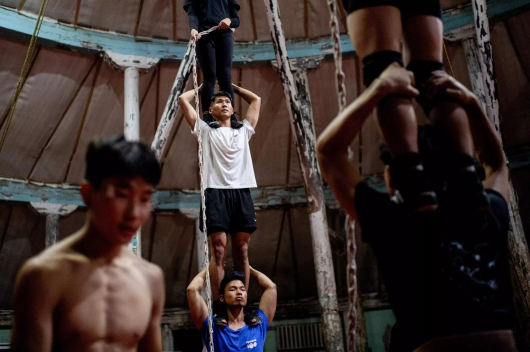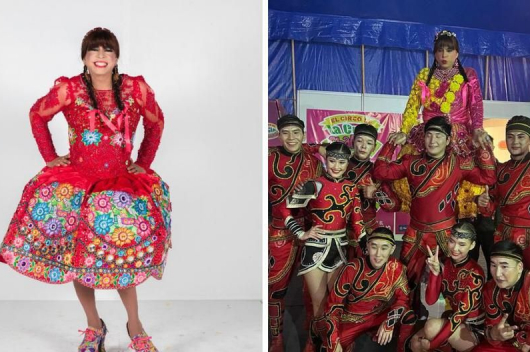It’s cold as a walk-in refrigerator at the Mongolian Circus School, housed in a once-proud edifice now on the verge of collapse with cracked walls, moldy ceilings and the stale smell of decades of cigarette smoke embedded into the venue’s wooden frame.
A group of teenage acrobats shrug off the frigid, fraying surroundings to practice leaping and somersaulting through the air, kicking up dust as they land, and enduring the bark of a gruff instructor needling them after each imperfection.
Outside on an unpaved driveway, a pair of girls in leotards, one age 11 and the other 13, tiptoe around puddles of muddy water to practice one of the most difficult and dangerous contortionist poses, the Marinelli bend. They bite a pad of leather attached to the end of a metal stand and use their jaws to help lift up their bodies. They muster enough strength to curl backward until their buttocks rest on the back of their heads and their legs stretch out in front of their faces like a scorpion’s tail.
The dexterity and determination of youngsters like these help explain why Mongolia churns out some of the most coveted circus performers in the world for marquee names including Cirque du Soleil and Ringling Brothers. This, despite a lack of government support and a dearth of training facilities. The 83-year-old Mongolian Circus School building is one of the only places where professionals and students can still prepare.
“We are wanted all over the world, but we can’t even properly train in our own country,” said Gerelbaatar Yunden, a former acrobat and circus director who estimates there are currently about 1,300 Mongolian performers working in North America and Europe.
The story of how Mongolia, a sparsely populated country almost the size of Alaska, ended up having so much talent and then wound up sending so many overseas has its origins in the country’s former state circus.

This homegrown circus once needed lots of trained performers. But that hasn’t been the case for many years, so there has been an exodus, driven in part by the sale of that circus to a famed Mongolian sumo wrestler, who conquered Japan’s most sacred sport but failed to live up to his promise to revive Mongolia’s cherished tradition.
While Mongolian contortionists have practiced the art form for centuries — mostly for the enjoyment of nobility — the idea of combining the discipline with music, clowns, animals and acrobats under one roof didn’t take root until 1931. That is when a group of Russian circus performers toured Mongolia, then a Soviet satellite state.
Mongolians were so enthralled by the visiting Russians that they sent students to Moscow to learn how to put together a similar show. Those students came back and established the first Mongolian circus in 1940. They found a home in what is now the crumbling Mongolian Circus School, a squat, round building meant to resemble a nomadic tent known as a ger.
Three decades later, in 1971, Romania, a fellow socialist country, helped Mongolia build a modern circus facility that could seat thousands more people, its blue-domed roof standing out amid Ulaanbaatar’s drab Soviet-style cityscape. For a developing country, the new circus was the epitome of entertainment. Generations of Mongolians would visit the state-run show each year, dazzled by the shiny costumes, the orchestra and the death-defying feats.
“People loved it because it was modern,” said Gerelbaatar, 43, who remembers attending the circus as far back as the 1980s. “It was different from traditional arts. It was something fresh.”

The show fell on hard times after Mongolia started phasing out its state-run economy in the wake of its democratic revolution in 1990. By the next decade, the government could no longer afford to maintain the circus and started looking for buyers.
One of the most famous Mongolians at the time was a sumo champion named Dagvadorj Dolgorsuren, better known by his Japanese professional name, Asashoryu. A dominant force in sumo for much of the 2000s, Asashoryu was also considered the sport’s enfant terrible and was the target of xenophobic treatment in Japan. He raised hackles for breaching sumo’s rigid etiquette by cracking a smile after a victory and not yielding to an older wrestler in a bathhouse corridor.
Asashoryu was idolized in Mongolia, where he was also a major investor in property and mining. In 2007, he bought the circus and vowed to restore the show to its former glory. He said he would allow performers to train at the modern arena free of charge and raise salaries to attract more talent. He called his new production the Asa Circus.
Dashdendev Nyam, who had been performing abroad as an acrobat and a juggler, rushed back to Mongolia after hearing of the sale. He wanted to see if there were new opportunities at home.

The new owner’s promises quickly proved too good to be true. According to Dashdendev, Asashoryu often wanted performers to work without pay. He strictly limited access to the blue-domed venue for training. And the few performers offered contracts had no guarantee they would be kept beyond a year. The circus, already limping along when Asashoryu bought it, was left with a skeleton crew, performing only a handful of shows every few months.
“Everyone started to give up after a few years,” said Dashdendev, 38, who eventually found work touring the United States with the Ringling Bros. “We were very sad because it felt like our heritage and our culture was being taken away.”
Asashoryu and Mongolia’s Ministry of Culture did not respond to requests for comment.
Performers have banded together in recent years to pressure the government to provide more training space, but to no avail. Meanwhile, Asashoryu’s arena has largely been used for concerts, not circus productions or training. The venue, which has been undergoing renovation since 2018, is closed off by temporary fencing, vandalized by graffiti.

The situation has frustrated performers including Tsatsral Erdenebileg, a contortionist at Cirque du Soleil’s “Zumanity” in Las Vegas. Without a clean, safe space for youngsters to learn, she fears the country’s circus tradition will eventually disappear.
The Mongolian Circus School building “doesn’t have hot water, it doesn’t have heat, and it doesn’t have enough light,” said Tsatsral, 36, who holds the Guinness World Record for the longest Marinelli bend. “It’s dangerous for children to be there.”
Tsatsral, who has been performing since she was a young girl, said she would have dedicated her career to a state-supported national circus had there been one in Mongolia. Instead, she has had no choice but to perform abroad.
Leaving Mongolia can be harrowing for young performers, Tsatsral said, noting that some are taken advantage of by agents seeking lopsided contracts. For her, moving to Las Vegas was difficult given the extreme differences in climate compared with Mongolia. She suffered from a vitamin D deficiency after she arrived because, in trying to avoid the heat, she virtually never went outdoors.
A saving grace about life so far from home is the abundance of countrymen and women performing alongside her. There are so many that they call themselves the “Mongolian contortion mafia,” Tsatsral said. On days off, they potluck Mongolian food and share the latest gossip from home.
“We have each other, but I still really miss my home,” Tsatsral said. “My dream is to teach the young Mongolian generation so they can go to Cirque du Soleil, but where am I going to teach?”
(source: The New York Times)
 3,413.51
3,413.51












Related News